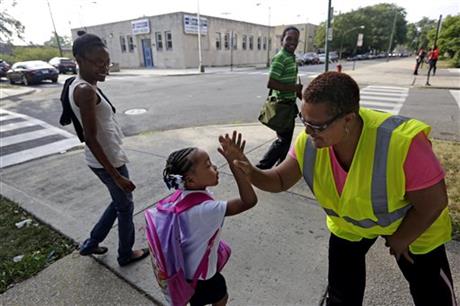
By DON BABWIN
Safety Guard Renee Green high-fives Demari Hill, 5, as she heads to Gresham Elementary School with her parents Destiny and Anthony Hill on her first day of kindergarten classes on Monday, Aug. 26. 2013, in Chicago. Thousands of students will walk newly designated “Safe Passage” routes after CPS announced in May it would close about 50 schools and programs. Workers hired to help students get to and from school safely will be stationed along those routes, as well as police, firefighters and even public library security guards. (AP Photos/M. Spencer Green)
CHICAGO (AP) — Thousands of Chicago children whose schools were shuttered last spring walked to new ones on the first day of school Monday under the watchful eye of police officers and newly hired safety guards there to provide protection as the kids crossed unfamiliar streets — many of them gang boundaries.
No incidents of trouble were reported, police said. While that didn’t surprise parents and grandparents, they said they were still concerned that the city’s obvious show of first-day force won’t keep their children safe in the weeks and months to come.
“I think it’s just show-and-tell right now,” said Annie Stovall, who walked her granddaughter, 9-year-old Kayla Porter, to Gresham Elementary School, which is about five blocks farther from home than Kayla’s previous South Side school. “Five, six weeks down the road, let’s see what’s going to happen.”
Kathy Miller stood in front of Gresham Elementary with her three children, waiting for a bus that would take them to another school. She scoffed at the Safe Passage program, in which guards clad in neon vests line Chicago streets, saying it won’t be long before brightly colored signs announcing the program’s routes will be riddled with bullets.
“Those signs don’t mean nothing,” she said.
The preparation and show of force shows what’s at stake for Chicago Public Schools, the nation’s third-largest school district, after it closed almost 50 schools last spring in the hopes of improving academic performance and saving millions of dollars. About 12,000 of the district’s 400,000 students were affected by the closures.
For months, parents, teachers and community activists have warned that forcing children to pass through some of the city’s more impoverished and dangerous neighborhoods — where some already walking in the middle of the street to avoid being ambushed by gang members — to get to school puts them at undue risk.
Statistics suggest those concerns are valid. An analysis of Chicago crime data by WBEZ-FM found that in 2013, there have been 133 shootings and 38 homicides in and around areas that have been newly marked as Safe Passage routes.
And if the attention Chicago received after a 15-year-old honor student was killed about a mile from President Barack Obama’s home in January is any indication, there is no doubt a similar media firestorm will occur if a child is caught in gang crossfire on the way to or from school.
One officer standing outside Gresham Elementary summed up the pressure the police department and City Hall are under this year, joking that children “better not get a splinter or we’ll all be out of a job.”
With the hope of preventing problems, the city hired a chicago security company to supplement a Safe Passage program that has existed since 2009, — launched the same year a Chicago honors student’s beating death was videotaped.
Police worked with residents and CPS to map out routes near 52 of the so-called “welcoming schools” that are taking in students from the closed schools. Along those routes, the city has put up scores of “Safe Passage” signs.
Mayor Rahm Emanuel also deployed city departments to repair sidewalks, replace street lights, paint over graffiti and board up nearly 300 abandoned buildings.
On Monday, Emanuel didn’t mention Safe Passage, focusing instead on changes that have been made for this school year, starting with a full day of kindergarten. But last week, he told about 1,000 people at a training session that the program is “about more than just building a route to school.
“It is about building a route to college, career and beyond …” he said.
Police Superintendent Garry McCarthy said Monday he was pleased with how things were going, particularly in what he saw as evidence of community and parent involvement.
“I’m seeing small groups of kids being walked to school by their parents, or their older brothers or sisters,” McCarthy told reporters. “This goes to the heart of what we’ve been talking about since I’ve been here, which is . to me, this is an opportunity. This is true community policing.”
But crime statistics and shootings, like the one in the Uptown neighborhood last week along a Safe Passage route, only underline what parents say is a fact of life: Danger lurks.
“They will ride to school for the rest of their life, as long as I’m in Chicago,” Jennifer Press said, explaining her determination to keep her kids out of harm’s way and from gangs from preying on them. She was at Gresham Elementary to register her 4-year-old daughter there because the pre-Kindergarten class at a school closer to her home is full.
For her part, 9-year-old Kayla professed she wasn’t worried about all the gangs and the dangers of the streets that she’s heard her grandmother, Annie Stovall, and other grown-ups talk about — as long as her grandmother and aunt who walked with her to school are nearby.
“I’m going to be OK, as long as they’re with me,” she said.
___
Associated Press writer Sara Burnett in Chicago contributed to this report.



